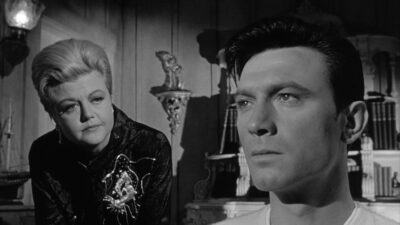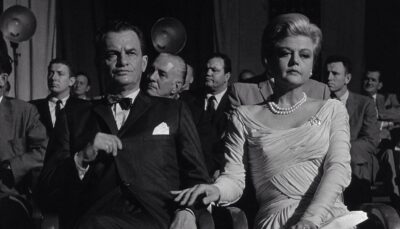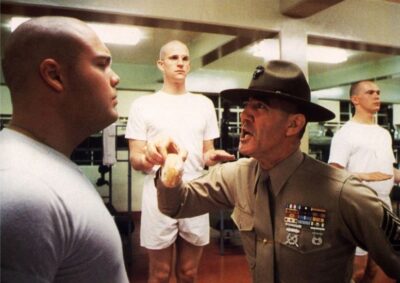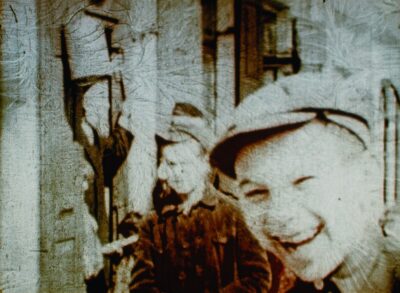



As a tribute to the late Angela Lansbury, we present a 60th anniversary screening of the movie that she considered her greatest achievement, The Manchurian Candidate. When Lansbury joined us in person for a sold-out anniversary screening of Death on the Nile in 2018, she told the audience that The Manchurian Candidate was her favorite of all her film roles. She received her third and final Oscar nomination for her performance in this 1962 movie. The screening is Wednesday, November 16, 7 PM at the Royal Theater.

John Frankenheimer’s film was a hit in 1962 and remains one of the most highly acclaimed of all political thrillers. In 1994 it was selected for the National Film Registry of the Library of Congress, an honor reserved for films of “historical, cultural, or aesthetic significance.” This story of a diabolical plot to engineer a Russian takeover of the White House was provocative in 1962 and seems frighteningly prescient today. As Frankenheimer said in remarkably prophetic comments a few years before his death, “I think our society is brainwashed by television commercials, by advertising, by politicians, by a censored press… More and more I think that our society is becoming manipulated and controlled.”

The Manchurian Candidate was adapted from Richard Condon’s novel by screenwriter George Axelrod, who also wrote such films as The Seven-Year Itch and Breakfast at Tiffany’s. It tells the chilling story of a soldier in the Korean War, played by Laurence Harvey, who is captured and brainwashed by Russian and Chinese Communists into becoming an assassin in the employ of the Soviet regime. Frank Sinatra plays a fellow soldier trying to halt the assassination plot. Lansbury won awards from the Hollywood Foreign Press and the National Board of Review for her portrayal of Harvey’s manipulative mother, who plays a crucial role in the conspiracy.

In addition to its achievements as a political thriller, the film was one of the first to satirize the anti-Communist hysteria that had gripped the country and divided the Hollywood community during the 1950s. James Gregory plays Lansbury’s husband, a dimwitted U.S. Senator modeled on Joseph McCarthy. This mockery of fanatical politicians enraged right wing pundits at the time of the film’s release, but it received the best reviews of any movie released in 1962. Variety wrote, “Every once in a rare while a film comes along that works in all departments… Such is The Manchurian Candidate.”
Over the years, rave reviews continued to pour in. Roger Ebert called it “a work as alive and smart as when it was first released.” Pauline Kael said, “The picture plays some wonderful, crazy games about the Right and the Left; although it’s a thriller, it may be the most sophisticated political satire ever made in Hollywood.” Writing in Time magazine in 2007, Richard Corliss said, “Lansbury and Harvey are both sensational in a movie that remains pointed and current. It still touches you like a clammy hand in the dark.”
Lansbury’s portrayal of the malevolent Mrs. Iselin was ranked as one of the 25 greatest villains in film history by the American Film Institute. Unlike other female villains in film noir, who were motivated by sex or money, Lansbury’s character had much more grandiose ambitions; her aim was to become the most powerful person in the entire country, a concept that was way ahead of its time in 1962.
After the screening, Stephen Farber and Michael McClellan, co-authors of Cinema ’62: The Greatest Year at the Movies (which includes a lengthy section on The Manchurian Candidate) will discuss the film with the audience. Other surprise guests may join the conversation.
Laemmle Theatres is pleased to announce that veteran film critic Stephen Farber’s popular REEL TALK WITH STEPHEN FARBER screening series is moving to Laemmle’s Monica Film Center this fall! See a variety of outstanding films from the U.S. and around the world, including many top awards contenders. Then meet the filmmakers for provocative and revealing discussions led by Stephen. The first screening — CALL JANE — will be October 17 and special guests will be announced soon. Visit laemmle.com/reeltalk for updates.
Recent films and speakers at Reel Talk have included:
MRS. HARRIS GOES TO PARIS, with director Anthony Fabian;
THE PHANTOM OF THE OPEN, with actors Christian Lees and Jonah Lees;
HAPPENING, with director Audrey Diwan and actress Anamaria Vartolomei;
THE UNBEARABLE WEIGHT OF MASSIVE TALENT, with director/co-writer Tom Gormican and co-writer Kevin Etten;
OPERATION MINCEMEAT, with screenwriter Michelle Ashford;
FIDDLER’S JOURNEY TO THE BIG SCREEN, with producer Sasha Berman and co-writer Michael Sragow;
AS THEY MADE US, with writer-director Mayim Bialik.
Laemmle Theatres and the Anniversary Classics Series present a 35th anniversary screening of Stanley Kubrick’s savage anti-war drama Full Metal Jacket, which scored a box office success in 1987 and also earned an Oscar nomination for Best Adapted Screenplay. Kubrick, celebrated Vietnam author Michael Herr, and Gustav Hasford adapted Hasford’s 1979 novel, The Short-Timers. The acclaimed cast includes Matthew Modine, Vincent D’Onofrio, Adam Baldwin, Dorian Harewood, and R. Lee Ermey. D’Onofrio will join for a Q&A after the 7 PM screening at the Royal on Tuesday, September 13.

Kubrick came late to the Vietnam war movie cycle, after such Oscar-winning films as Coming Home, The Deer Hunter, and Platoon. But he added his own sardonic and biting slant to his dissection of the terrible war. One of Kubrick’s early celebrated movies was his 1957 drama Paths of Glory, set during World War I. And his 1964 Oscar nominee, Dr. Strangelove, took a unique black comic approach to the terrifying subject of nuclear annihilation. Some of the same dark humor freshens Full Metal Jacket, though it also contains deadly serious depictions of brutal basic training as well as the horrors of a misguided, doomed war.

The first section of the film dramatizes the basic training of a platoon of Marine recruits at Parris Island, South Carolina. Former real-life drill instructor R. Lee Ermey portrays the savage sergeant in charge of the soldiers’ training. Ermey improvised much of the scathing and scatological dialogue, based on his own personal experience as a sergeant during the Vietnam War. He bullies and brutalizes all of the recruits but takes special pleasure in tormenting the overweight soldier played by D’Onofrio, whom he nicknames Gomer Pyle. Modine tries to protect D’Onofrio, with little success.

When the action shifts to Vietnam during the Tet offensive, it retains its hard-edged, nihilistic spirit. The entire film was actually shot in England, but Kubrick and his technical crew did an extraordinary job of recreating an American military base and the cities and jungles of Southeast Asia without ever leaving the English countryside.
Critical reactions to the film were very strong. Gene Siskel called Full Metal Jacket “a great piece of filmmaking.” The Los Angeles Times’ Sheila Benson wrote, “Aiming for minds as well as hearts, Kubrick hits his target squarely.” The Chicago Reader’s Jonathan Rosenbaum raved, “This is the most tightly crafted Kubrick film since Dr. Strangelove, as well as the most horrific.” The New York Times’ Vincent Canby called it “a film of immense and very rare imagination.” Canby’s Times colleague Janet Maslin added, “No one who sees Full Metal Jacket will easily put the film’s last glimpse of D’Onofrio, or a great many other things about Kubrick’s latest and most sobering vision, out of mind.”
After his breakthrough performance in Full Metal Jacket, D’Onofrio went on to co-star in such films as Mystic Pizza, JFK, The Player, Ed Wood, The Whole Wide World, Men in Black, Jurassic World, and Steal This Movie, in which he played Abbie Hoffman. He had a ten-year run in Law and Order: Criminal Intent. More recently he has appeared in the series Daredevil, Godfather of Harlem, and Ratched. Last year he had a major role as Jerry Falwell in the Oscar-winning The Eyes of Tammy Faye.
The beautiful new documentary feature Three Minutes: A Lengthening is based on a mere three minutes of footage, shot by David Kurtz in 1938, that are the only moving images remaining of the Jewish inhabitants of Nasielsk, Poland before the Holocaust. Director Bianca Stigter takes those three minutes and expands and explores them to create “an original and incisive meditation on history, memory, memorials and the very nature of celluloid.” (Alissa Simon, Variety) We open the film August 19 at the Royal and August 26 at the Town Center. The August 16 at the Royal will be hosted by the Los Angeles Jewish Film Festival and followed by a discussion with Ms. Stigter and author Glenn Kurtz. Scholar Michael Berenbaum of American Jewish University will moderate.
Director Bianca Stigter’s statement:
“As a child, David Kurtz emigrated from Poland to the United States. In 1938 he returned to Europe for a sightseeing trip and whilst there he visited Nasielsk, the town of his birth. Specifically for this trip, he bought a 16mm camera, then still a novelty rarely seen in a small town never visited by tourists. Eighty years later his ordinary pictures, most of them in color, have become something extraordinary. They are the only moving images that remain of Nasielsk prior to the Second World War. Almost all the people we see were murdered in the Holocaust.

“On Facebook, I stumbled upon a book written about this film, Three Minutes in Poland by Glenn Kurtz. The title fascinated me. I ordered the book and watched the footage, which can be found on the website of the United States Holocaust Memorial Museum. While watching, I wondered: could you make those three minutes last longer, to keep the past in the present?
“For this film essay, I examined the footage in the fullest detail, to see what the celluloid would yield to viewers almost a century later. The footage is treated as an archaeological artifact to gain entrance to the past.

“I contacted Glenn Kurtz, traveled to Nasielsk to see if any traces remained from the past, and went to Detroit to speak with survivor Maurice Chandler and his family.
“After this extensive research, I edited the footage in different ways to bring to life as many of the facts and stories about Nasielsk as possible. A few seconds of the recording of a café becomes a dance scene, a single shot of the market square tells the story of the deportation of its Jewish citizens. All the faces that appear in the film are singled out and magnified to pay homage to the people of Nasielsk. The old images of the Polish town are combined with the way Nasielsk sounds today, creating a tense fusion of the past and the present.

“Three Minutes: A Lengthening is an experiment that turns scarcity into a quality. Living in a time marked by an abundance of images that are never viewed twice, we do the opposite here: circle the same moments again and again, convinced that they will give us a different meaning each time. The film starts and ends with the same unedited found footage, but the second time you will look at it quite differently.
“Three Minutes: A Lengthening investigates the nature of film and the perception of time. Through the act of watching, the viewers partake in the creation of a memorial.”
“When apparatuses like these are available to the public, when everyone can photograph those who are dear to them, not only their posed forms but their movements, their actions, their familiar gestures, with words at the tip of their tongues, death will cease to be absolute.’’ ~ The French newspaper La Poste, 30 December 1895, after the Lumières’ first public showing of a film in Paris.
A coming-of-age comedy-drama about three Black women living in Brooklyn, Ayoka Chenzira’s 1993 film Alma’s Rainbow explores the life of teenager Rainbow Gold, who is entering womanhood and navigating conversations and experiences around standards of beauty, self-image, and the rights Black women have over their bodies. We are thrilled to open the film next Friday, August 12 at the Monica Film Center.
Victoria Platt, who starred as Alma, will participate in a Q&A after the evening screening on Saturday, August 13th, exact showtime TBA.
All screenings of Alma’s Rainbow will be preceded by Ms. Chenzira’s 10-minute animated short film Hair Piece: A Film for Nappy Headed People (1984).

“With a whole lot of heart and humor, Ayoka Chenzira’s Alma’s Rainbow is a stunning exploration of Black identity and the dynamism of Black women’s lives.” – Maya Cade, Black Film Archive creator
“The matter of matriarchy within families is close to my heart. I think of my great-grandmother, my grandmother, my mother, and my aunts who all had a firm, beautiful hand in raising me. I long for more representations of these generational villages on screen, like those we experience in Ayoka Chenzira’s work. Ms. Chenzira’s Alma’s Rainbow is a gorgeous clarion call for our young Black girls, heralding the community, creativity and confidence that is the pride of our culture.” —Ava DuVernay, producer-director

“I am delighted to have this opportunity to join you in presenting Dr. Ayo Chenzira’s first feature film. As you know, Alma’s Rainbow was one of the first full length dramatic narrative films produced and directed by an African American woman in the 20th century. Chenzira’s much celebrated and award winning early work is essential viewing today as much as it was when first released in 1994.” —Julie Dash, filmmaker

Director’s Statement: “I could write a book on the response to Alma’s Rainbow. The film took a long time to make. I raised all the money independently. Distributors came and looked at the film, and there was a real split between what the men thought about it and what the women thought about it. The response by women has been overwhelmingly positive. The response by men, who write the checks, was that it was not an action piece. There was no Black pathology; there was no movie point of reference for three Black women driving a story. They also see that it is not a linear narrative in the tradition of exposition, climax and resolution. The editing and storytelling are based on the emotions of the characters. This is something that women understood and men did not.

“We found a distributor who was not interested in selling it only to twenty-something White guys in the suburbs. Unfortunately, the arrangement with the distributor and our company did not work out; we did get the film back, however, unencumbered. This film grows out of mothers being afraid of their daughters’ own budding sensuality.” – Ayoka Chenzira, Ph.D.
This Friday at the Royal and Town Center, we open My Name is Sara, a drama based on a true story from the Second World War about a young Polish Jew who survived by taking refuge with farmers and passing as a Christian. The director, Steven Oritt, and leading actress Zuzanna Surowy will participate in Q&As Friday, July 22 after the 7 PM at the Royal; Saturday, July 23 after the 4 PM show at the Royal and after the 7:10 PM show in Encino; and on Sunday, July 24, after the 1:10 PM in Encino and the 4 PM show at the Royal. Executive producer Mickey Shapiro (the real-life Sara’s son) will join them for the Friday Q&A.

The filmmaker recently spoke with Brian Fishbach of the Jewish Journal:
Three dead people hang from a tree with a sign that reads “We hid Jews.” It’s a scene that encapsulates the fear tactics the Nazis used to deter anyone from assisting the Jewish people during World War II.
The film My Name Is Sara tells the true and arduous story of a Jewish girl who survived by pretending not to be Jewish. It shows how Sara Góralniak (Zuzanna Surowy), a 12-year-old living in Poland, took refuge on a farm in Ukraine for two years while hiding every aspect of her Jewish identity. Every second that she was there she knew that if she were found, she and the family that protected her would be murdered.

“She was constantly living on eggshells that entire time, which is an obviously awful environment to have to live under,” said director Steven Oritt.
Throughout the film, Sara endears herself to the family who allows her to work on their farm: Pavlo (Eryk Lubos), his wife Nadya (Michalina Olszańska) and their two young sons. Sara proves herself to be a capable farmhand and a non-Jew by reciting the Lord’s Prayer, eating pork, saying she’s 14 and even assuming a new name. She endures skepticism from the family that has taken her in, while also slowly proving herself useful and not threatening their safety.

There are scenes of animals being slaughtered, as is normal on any farm. But there’s humanity in those moments, which is in contrast to the graphic and sadistic threats and murders of the townspeople at the hands of the Nazis.
The ensemble is strong, making every peril Sara and the family confront vivid and poignant, their eyes and body language expressing the characters’ fear and determination. No moment illustrates this better than Sara, riding a horse drawn buggy into town with Pavlo and Nadya’s family, sees three townspeople hanging from a tree for hiding Jews. Both Nadya and Sara cover the two little boys’ eyes. Sara’s dreams of reuniting with her family turn to nightmares when their reunion is discovered by Nazis.

Surprisingly, the starring role of Sara was Surowy’s first time acting. Thrust into a movie set and working in English, which is not her first language, Surowy’s experience mirrors Sara’s. There’s a fear, a wariness, to her performance, that’s most effective when Sara, who had never worked on a farm or been away from her family, is forced to adapt to her new world.
“We weren’t going to make the film if we didn’t find somebody that we felt as though could pull it off,” said Oritt.
While the two previous films he directed were documentaries, this is the first scripted film Oritt’s directed. “When I first interviewed [the real] Sara, the first question I asked was ‘How does a child, a 12-year old, survive such a thing?’ Because it was an unimaginable event. How could she do this constantly, making the right choice happen? And she said immediately, ‘by listening and not talking.’”
Read the full piece on the Jewish Journal site.
